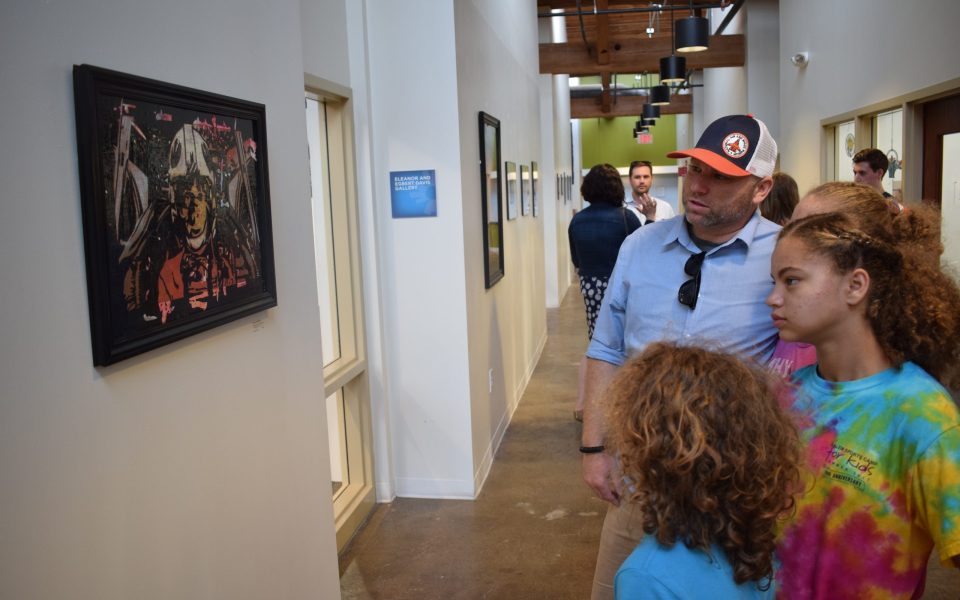While working through a dilemma with one of his students around the end of the 2016 school year, Steve McCarthy encountered a new area of exploration that would alter the trajectory of his visual-arts career.
McCarthy, an art teacher for more than two decades who is currently assigned to Parkland High School in Winston-Salem, developed a new and versatile process that applies principles derived from the wax-resist technique that he is calling “pastel resist.” McCarthy’s method involves crayon or oil pastel overlaid with acrylic, latex and enamel paints. Once dried, the top layer of paints is cut and removed, revealing a layer of color beneath.
“This process was a discovery,” McCarthy said. “We were trying to figure out why [the students] were having trouble getting the ink or tempera paint to scratch off, [and] I thought that instead of tempera paint [the students] used acrylic paint because I saw some sitting out. Acrylic is more plastic-y.”
His suspicion turned out to be incorrect — the student most likely didn’t color the area underneath as densely as necessary — but McCarthy began experiments that led to the development of his pastel-resist process. According to McCarthy, oil pastel resists acrylic, a water-based substance, which enables him to cut and remove the acrylic top layer.
“It turned out you could do some pretty cool stuff that way,” McCarthy said. “I think the process is as much on display here as the subject because it’s such a different process; I haven’t seen it before.”
On Aug. 4, McCarthy’s first solo exhibit debuted with a reception. The Art of Resistance: Explorations in Pastel and Acrylic explores a mix of pop-cultural iconography and representations of the natural world and is housed in the Sawtooth School for Visual Art, a community art school that offers a broad range of classes and workshops for all ages, along with exhibit space.[pullquote]Visit McCarthy’s exhibit at Sawtooth School for Visual Arts, 251 N. Spruce St. (W-S) and learn more at sawtooth.org.[/pullquote]
McCarthy said iconic pop artists Andy Warhol and Shepard Fairey inspire much of his work, but most of his subject matter comes from his everyday life.
“I was thinking, Who in my lifetime has been significant to me or significant in the broader context of my life?” McCarthy said.
Last summer, his son took a photo of a newt while exploring a riverbed, and the image became the inspiration for a large pastel-resist painting. McCarthy said the piece kickstarted the motif of natural imagery in his pastel-resist work, such as a stoic heron in the foreground of bold blues and greens that captivated many guests at the reception.
Michelle Merritt Leonard of Bethania loved the heron, but McCarthy’s “Black Widow” — a rendering of the Marvel character — stole her heart. Hot-pink, blue and subtle purple accents outline the fictional superhero’s otherwise shadowy representation.
Another piece depicts the pop star Rihanna.
“They’re very colorful and bright and aren’t an exact depiction of the images you see,” Leonard said. “[McCarthy] adds a little more nuance and lots of layers of color, so even if you didn’t know who [the portraits] are [the piece] would still be interesting. You don’t see Rihanna first, you see [the whole] and then realize it’s Rihanna.”
Michael Sullivan, who works with McCarthy at Parkland High, said he recognized and appreciated the complex layering work McCarthy blends into his art pieces. A door connects their classrooms and the two often share new projects with one another.
“I love the pop-culture [references] but I also love the layers,” Sullivan said. “If you look closely, there are different [features] you can see that jump out. It’s a very time-consuming process, and I love how it all comes together.”
Sullivan’s favorite piece is a flower-filled silhouette of a maroon vase superimposed over a background of swirling peach and mint tones because Sullivan knows how many focused hours McCarthy spent whittling away tiny incisions with his X-Acto knife.
Sullivan said The Art of Resistance is also a story about the nature of the student-teacher relationship and the collaborative problem-solving it demands.
“Art is all about experimentation,” Sullivan said. “It’s a form of communication and a way to think creatively. I always tell students… we need to have the book smarts but the future problems that you’re going to face, you have to solve them creatively and the way you can do that is to think creatively; that’s one of the things art can do for you.”
Join the First Amendment Society, a membership that goes directly to funding TCB‘s newsroom.
We believe that reporting can save the world.
The TCB First Amendment Society recognizes the vital role of a free, unfettered press with a bundling of local experiences designed to build community, and unique engagements with our newsroom that will help you understand, and shape, local journalism’s critical role in uplifting the people in our cities.
All revenue goes directly into the newsroom as reporters’ salaries and freelance commissions.


Leave a Reply